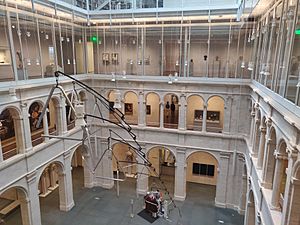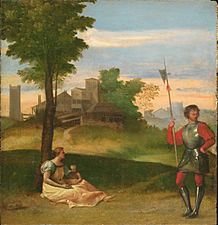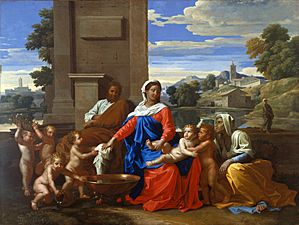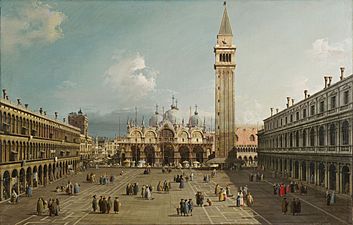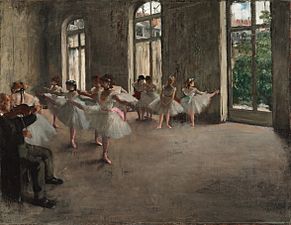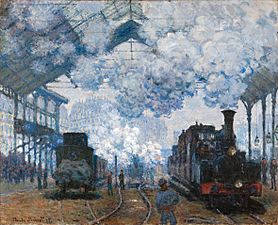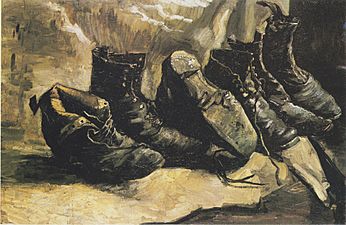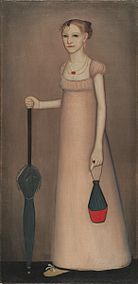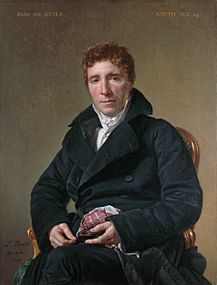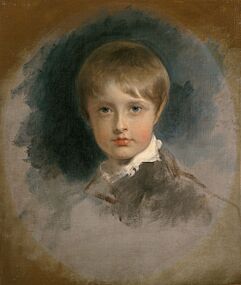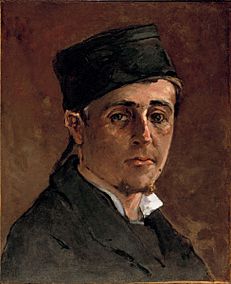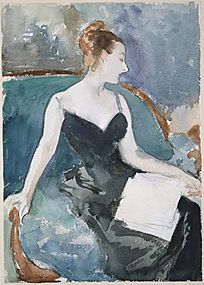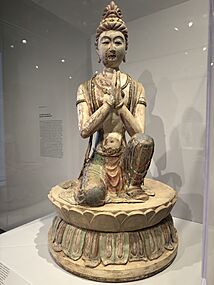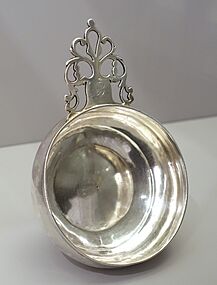Harvard Art Museums facts for kids
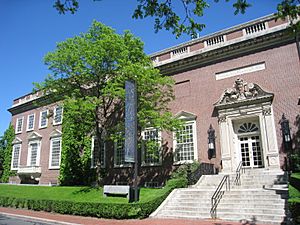
The original Fogg Art Museum is one of the main entryways to the Harvard Art Museums
|
|
| Established | 1983 (by merger of 3 earlier museums) |
|---|---|
| Location | 32 Quincy Street Cambridge, Massachusetts, U.S. |
| Type | Art museum |
| Collection size | ~250,000 |
| Architect | Renzo Piano |
| Owner | Harvard University |
| Public transit access | Harvard (MBTA Red Line) |
The Harvard Art Museums are a group of three amazing art museums and four research centers. They are all part of Harvard University in Cambridge, Massachusetts. The three museums are the Fogg Museum, the Busch-Reisinger Museum, and the Arthur M. Sackler Museum.
These museums came together in 1983 to form one big institution. They hold about 250,000 art pieces! These artworks come from all over the world and from different times in history. You can see art from ancient times up to today. The main building has lots of space for showing art, classrooms, and special labs where experts study and care for the artworks.
Contents
A Modern Makeover for the Museums
In 2008, the main building of the Harvard Art Museums closed for a big update. This project made the building much larger and more modern. During this time, some of the art was shown at the Arthur M. Sackler Museum.
The famous architect Renzo Piano designed the new look. He connected the three museums into one building. This added 40% more space for art galleries! He also added a cool glass roof shaped like a pyramid. Even with all these changes, the front of the building still looks much like it did before. The new building opened in November 2014. It now has six floors of galleries, classrooms, and study areas. This means more of the 250,000 artworks can be seen and studied.
Meet the Museum Directors
- Charles Herbert Moore: 1896–1909
- Edward W. Forbes: 1909–1944
- John Coolidge: 1948–1968
- Agnes Mongan: 1968–1971
- Daniel Robbins: 1972–1974
- Seymour Slive: 1975–1984
- Edgar Peters Bowron: 1985–1990
- James Cuno: 1991–2002
- Thomas W. Lentz: 2003–2015
- Martha Tedeschi: 2016–2024
- Sarah Ganz Blythe: 2024–present
The Fogg Museum: A Journey Through Western Art
The Fogg Museum first opened its doors in 1896. It is the oldest and largest part of the Harvard Art Museums.
Fogg Museum's Story
The Fogg Museum was not just a place to show art. It was also a school for learning about art. It had classrooms, a library, and many pictures of famous artworks. In 1925, a new building was built for the museum.
What You Can See at the Fogg Museum
The Fogg Museum is famous for its collection of Western art. This includes paintings, sculptures, photos, and drawings. The art ranges from the Middle Ages to today. You can find amazing pieces from the Italian Renaissance and French art from the 1800s. There are also many American paintings and drawings from the 1800s and 1900s.
One special part is the Maurice Wertheim Collection. It has many famous Impressionist and Post-Impressionist artworks. You can see masterpieces by artists like Paul Cézanne, Edgar Degas, Édouard Manet, Henri Matisse, Pablo Picasso, and Vincent van Gogh.
Another important collection is the Grenville L. Winthrop Collection. It has over 4,000 artworks! This collection helps teach students and researchers about art. It includes works by William Blake, Auguste Rodin, and John Singer Sargent.
The museum also has paintings from different periods:
- Late Medieval Italian paintings by artists like Simone Martini.
- Flemish Renaissance paintings by artists like Jan Provoost.
- Italian Renaissance paintings by artists like Sandro Botticelli.
- French Baroque paintings by artists like Nicolas Poussin.
- Dutch Master paintings by artists like Rembrandt.
- American paintings by artists like Winslow Homer and Jackson Pollock.
In 2021, the museums started a project called "ReFrame." This project aims to show more diverse artworks and tell more stories. It brings out hidden art and helps people see exhibits in new ways.
Gallery of Fogg Museum Highlights
-
Titian, Rustic Idyll, 1507–1508
-
Nicolas Poussin, Holy Family, 1645–1650
-
Canaletto, Piazza San Marco, Venice, c. 1730–1735
-
Albert Bierstadt, In the Sierras, 1868
-
Frédéric Bazille, Summer Scene, 1869
-
Edgar Degas, Cotton Merchants in New Orleans, 1873
-
Edgar Degas, The Rehearsal, 1873
-
Claude Monet, The Gare Saint-Lazare, Arrival of a Train, 1877
-
Vincent van Gogh, Three Pairs of Shoes, 1886
-
Paul Gauguin, Still Life with Apples, a Pear, and a Ceramic Portrait Jug, 1889
-
Henri de Toulouse-Lautrec, Gueule de bois, c. 1888
-
John Singleton Copley, Mrs. Daniel Denison Rogers (Abigail Bromfield), 1784
-
Thomas Lawrence, Portrait of Napoleon II, 1819
-
Paul Gauguin, Self portrait, c. 1875–1877
-
Edgar Degas, The Singer with the Glove, 1878
-
John Singer Sargent, Madame Gautreau (Madame X), c. 1883
-
Vincent van Gogh, Self-portrait dedicated to Paul Gauguin, 1888
-
Thomas Eakins, Miss Alice Kurtz, 1903
The Busch–Reisinger Museum: Art from German-Speaking Countries
The Busch–Reisinger Museum started in 1903 as the Germanic Museum. It got its new name in 1920. It was named after Adolphus Busch, a famous brewer, and his son-in-law, Hugo Reisinger.
This museum is special because it's the only one in North America focused on art from German-speaking countries. It covers all types of art from all time periods. You can see art from the Austrian Secession movement and German expressionism. It also has one of the largest collections of items from the Bauhaus design school. The Bauhaus was a very important school for modern design from 1919 to 1933.
The museum also has art from after World War II. This includes works by artists like Georg Baselitz and Gerhard Richter. It has a huge collection of works by Joseph Beuys.
You can find oil paintings by artists such as Gustav Klimt, Edvard Munch, and Max Beckmann. There are also sculptures by artists like Käthe Kollwitz.
From 1921 to 1991, the Busch–Reisinger was in Adolphus Busch Hall. This hall still has the museum's first collection of medieval plaster casts. It also hosts concerts with its special pipe organ. In 1991, the museum moved to the new Werner Otto Hall.
In 2019, the museum had an exhibit called The Bauhaus and Harvard. It celebrated 100 years since the Bauhaus school began. Many students and teachers from Bauhaus came to Harvard after the school closed in Germany. They continued their amazing work there.
Busch–Reisinger Curators
- Kuno Francke, 1903–1930
- Charles L. Kuhn, 1930–1968
- Peter Nisbet
- Lynette Roth
The Arthur M. Sackler Museum: Art from Asia and Beyond
The Arthur M. Sackler Museum opened in 1985. It was designed by a British architect named James Stirling. The museum was named after its main supporter, Arthur M. Sackler. This building used to show art, but now it mainly holds classrooms and offices for Harvard's art history department.
Important Collections at the Sackler Museum
The museum has amazing collections of Asian art. It has one of the largest collections of ancient Chinese jades outside of China. You can also see beautiful Chinese bronzes, Japanese paper art, and lacquer boxes.
The museum also has ancient art from the Mediterranean and Byzantine regions. This includes Greek vases, small bronze statues, and coins. There are also artworks on paper from Islamic lands and India. These include paintings, drawings, and beautiful writing.
About the Sackler Building's Design
The Sackler building was meant to be an addition to the Fogg Museum. Its design by James Stirling got a lot of attention. Stirling wanted the building to fit in with the other buildings around it.
The building was planned to have a long "connector" bridge. This bridge would have linked it to the Fogg Museum across the street. It would have had galleries and a special window. However, people in the neighborhood didn't want the bridge built, so it never happened. Today, you can still see two large concrete pillars in front of the Sackler building. These were supposed to support the bridge.
In 2013, the art collection from the Sackler Museum moved to the newly renovated Fogg building. In 2019, after some updates, the Sackler building reopened. It is now used for teaching and research, with no public art exhibits. It still has a large lecture hall in its basement.
See also
- National Register of Historic Places listings in Cambridge, Massachusetts
- List of university museums in the United States


